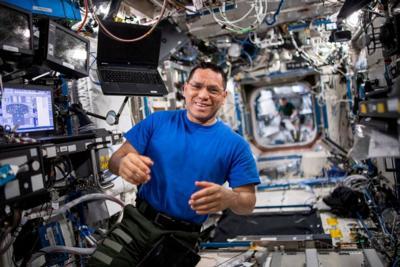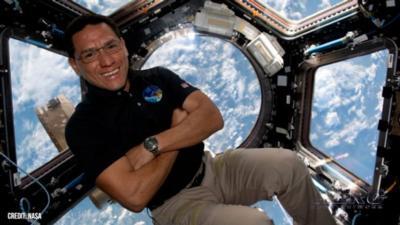Frank Rubio Headed Home after 371 Days In Space
On 11 September, NASA astronaut Frank Rubio, who’s currently serving out a year-long mission aboard the International Space Station (ISS), earned the distinction of logging the longest single spaceflight by an American, surpassing former record-holder NASA astronaut Mark Vande Hei’s mark of 355 days in space.

Comes now late-September, and Rubio is making ready to depart the orbital outpost he’s called home since 21 September 2022.
On Wednesday, 27 September 2023, Rubio and Roscosmos cosmonauts Sergey Prokopyev and Dmitri Petelin will undock their Soyuz MS-23 spacecraft from the station’s Prichal module at 03:55 EDT and begin the three-hour-twenty-minute trip back to gravity, Texas barbecue, Led Zeppelin laser shows, and the remainder of the Earthly delights they’ve been so long without.
The trio will return after 371 days in space and a mission spanning 157.4-million statute-miles and 5,963 orbits of Mother Earth. Soyuz MS-23 is scheduled to land on the steppe of Kazakhstan, southeast of the city of Dzhezkazgan, at approximately 07:17 EDT (17:14 East Kazakhstan/Alma-Ata Time - Zulu +6).
After landing, Rubio, Prokopyev and Petelin will be flown from the landing site to Karaganda, Kazakhstan, the capital and namesake of Kazakhstan’s Karaganda Region and the nation’s fifth most populous city. Karaganda will mark the divergence of Rubio’s path from Prokopyev’s and Petelin’s, as the astronaut will bid his comrades farewell, board a NASA plane, and endure an additional ten-hour, twenty-minute flight back to Houston.
Francisco Rubio was born to Salvadoran parents in Los Angeles, California on 11 December 1975—the day before the Satcom-1 communication satellite, which inspired the creation of ESPN—was launched into orbit by the RCA corporation. For the first six-years of his life, Rubio lived in El Salvador, after which his family relocated to Miami, Florida. He attended the United States Military Academy and earned a bachelor's degree in international relations.
Commissioned, upon graduation, as a Second Lieutenant in the U.S. Army, Rubio became a UH-60 Black Hawk pilot, a platoon leader in A Company 2nd Battalion, 82nd Airborne Division, and a company commander for A Company, 2nd Battalion, 3rd Aviation Regiment. As a pilot, Rubio logged some six-hundred combat hours in only one-thousand hours of total flying time.
Returning to the classroom, Rubio earned a Doctorate of Medicine degree from the Uniformed Services University of the Health Sciences. He completed a family medicine residency at Fort Benning and served as a clinic supervisor and flight surgeon at Redstone Arsenal. At the time of his 2017 selection as a NASA astronaut candidate, Rubio was the surgeon for 3rd Battalion, 10th Special Forces Group at Colorado’s Fort Carson.

Rubio was selected as a member of NASA Astronaut Group 22, and promptly undertook the space agency’s requisite two-year training program.
On 21 September 2022, Rubio blasted off for the International Space Station aboard Russia’s Soyuz MS-22 mission. He was to have remained in space for approximately six-months, returning to Earth in early 2023. Damage to the aforementioned spacecraft stranded Rubio aboard the ISS, however, prolonging his mission to well over one calendar year.
For more than 22-years, astronauts have continuously lived and worked aboard the International Space Station—some longer than others—maintaining the orbital facility, conducting scientific research, gauging microgravity’s and seclusion’s deleterious effects upon human physiology and psychology respectively, and developing, ostensibly, technologies and skills conducive to humankind’s aspiration to become a truly space-faring species.
 A Crazy Tesla Flying Car is Coming
A Crazy Tesla Flying Car is Coming ANN's Daily Aero-Term (11.xx.25): NonApproach Control Tower
ANN's Daily Aero-Term (11.xx.25): NonApproach Control Tower Aero-News: Quote of the Day (11.01.25)
Aero-News: Quote of the Day (11.01.25) ANN's Daily Aero-Linx (11.01.25)
ANN's Daily Aero-Linx (11.01.25) Classic Aero-TV: EAA Introduces Angle of Attack Training
Classic Aero-TV: EAA Introduces Angle of Attack Training




